As an Amazon Associate I earn from qualifying purchases.
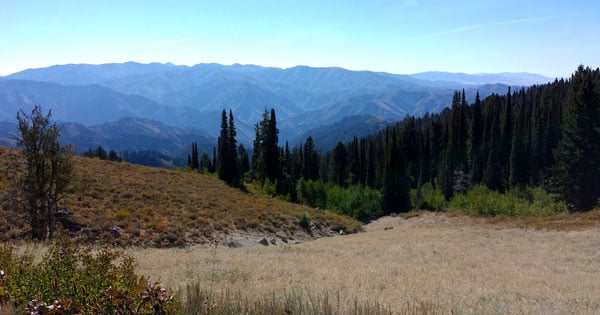
Deer hunting stirs something deep within me. And waterfowling becomes my primary occupation from November through January. But if forced, I’d give them both up to chase grouse. Any grouse will do, from silly fool hens and ptarmigan, which can be killed with a well-placed rock, to the fast-flying sharpies of the Great Plains and the wily ruffed grouse of the Northwoods. Yet no grouse has haunted me more than Big Blue.
Big blue as it happens, is actually two grouse, the sooty grouse of the Pacific West and the dusky grouse of the Rockies; until recent years they were considered one species. Whichever variant you are chasing, Big Blue is an enormous grouse, topping three pounds or more — significantly heavier than a pheasant, to give Midwesterners some context — who prefers the thin air and thick cover of alpine forests.
Over the years I’ve chased this grouse six ways to Sunday in four states, with no success. My hunts typically ran something like this: Oh, that was the hunt where we hiked at 10,500 feet in four feet of snow and we saw tracks, but no birds. Or, something like: Yeah, that was the one where we heard a grouse, we think… Or, most often, like this. Christ. Yeah, that was the hunt where Larry and Jamie and Steve all got birds, but I never saw a thing.
This time would be different, I hoped. A reader of Hunter Angler Gardener Cook, a woman named Jennifer whom Holly and I had never met in person, invited us to spend a few days at her family ranch near Oakley, Utah, in the foothills of the Uinta Mountains. She said there’d be grouse. We said OK, crossed our fingers and got in the truck.
When we arrived, we quickly realized that “foothills” was a cruel joke: The base camp, a Mad Max-esque array of random trailers surrounding a cooking pavilion corralled off from a herd of horses they call the Taliban, stood at a dizzying 7400 feet above sea level. And the hunt would be well above this.
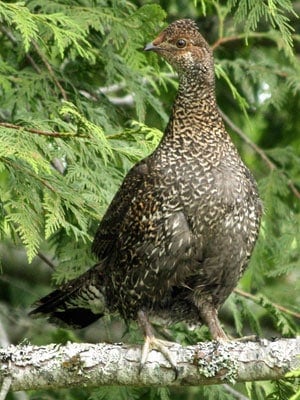
Blue grouse are like that. You can find them as low as 5000 feet somewhere, I guess, but I’ve never seen one lower than 7000 feet. Keep in mind you can get altitude sickness starting at about 8000 feet.
That first night Jennifer introduced us to the core of what would become a huge crew of campers (it was Labor Day weekend), including Darryl, a truck driver, and his wife Lisa, who’s involved in the Slow Food movement in Utah, as well as Cory and Sam, the Cheech and Chong of the camp.
Sam and Cory are both young contractors whose outward aura of laid-back stonerism didn’t really hide their insatiable desire to pursue wild game. They, along with Cory’s girlfriend Tyler and his dog Hank — yes, I’ve met all too many Hank the Hunting Dogs in my time — would be our closest hunting partners on this adventure.
Now Holly and I are duck hunters used to waking up long before dawn for a hunt; deer hunting forces you to do this, too. Early bird gets the bird, right? Apparently not with blue grouse. We were up at the leisurely hour of 7 a.m., only to find we were the only ones awake in camp. Disconcerting, to say the least. Darryl, Cory, Sam and Taylor rolled out closer to 8 a.m., and we didn’t get on the road until after nine. Holly and I were practically vibrating by then.
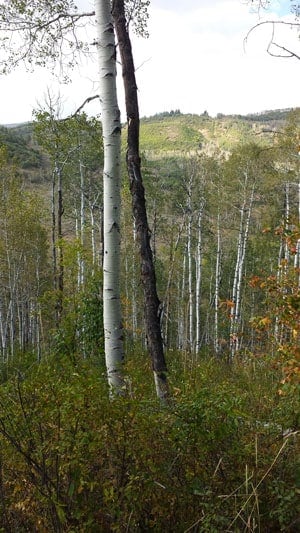
The ranch is gigantic: seven square miles of mountains and meadows, with a few creeks here and there. Aspen stands were the rule, until we got really high, where the hunting was in scrubby pines and mountain mahogany. The goal was to cover as much ground as possible, so we tooled around on ATVs until we got some sense of where the birds would be. If we found one, we’d get out and walk the area for a while.
Grouse in late summer and early fall don’t really range too far, and, according to Blue Grouse: Their Biology and Natural History, are often within 300 yards of where they roosted the previous night. But they do move constantly. And, to make hunting harder, they’re just as likely to be solo as they are to be in a covey. Over the hunt, we saw everything from big solo roosters (biologically speaking, grouse are mountain chickens, remember) to little flocks of mostly young-of-the-year birds.
Cory wanted to head up to a high spot first. A ruffed grouse hunter’s maxim is to hike up and hunt down, so this seemed appropriate. On our way, We passed a cornucopia of berries: mountain ash, saskatoons, hawthorn, chokecherries, creeping mahonia, rose hips, and, most importantly, acres of snowberry, Symphoricarpos albus. Grouse love this plant, seemingly more than any other.
I was musing on this when I heard Taylor say quietly, “There’s one.” I couldn’t see it, but Cory was out of the ATV like a shot. I followed, a second behind. We had just started walking up on the bird, which was sunning itself on a log, when it flew. Cory dropped it with one shot — a shot that alarmed a hidden friend of this bird, which flushed. For a nanosecond I thought here we go again, another case of everyone but me getting a bird, but I was lifting my shotgun even as I thought this depressing thought. A glimpse of a flushing bird, a shot, and, to my utter astonishment, the grouse dropped!
I bolted after the grouse so fast I might have been at sea level instead of 8500 feet. I’d winged it, and Hank the Hunting Dog was on the bird almost as fast as I was. Only I got there first. I lunged, but came up with only tailfeathers. Another lunge and I had my first ever blue grouse!
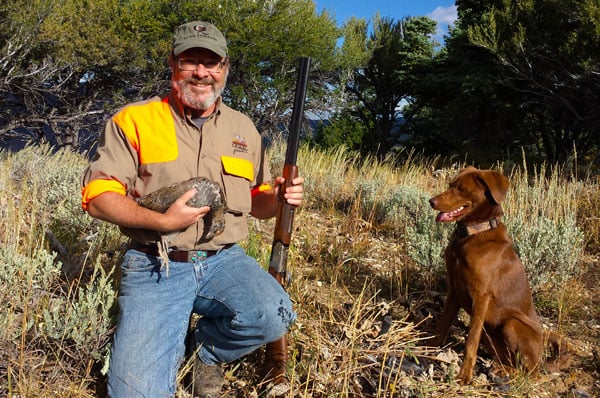
Finally! For years I’ve been waiting for this moment. And the bird did not disappoint. It was not as large as the big rooster Cory had dropped, but it was a mature male with that lovely slate gray pattern of feathers, with a little yellowish eyeliner and those fuzzy feet all grouse possess. And it was heavy. I later weighed the grouse plucked, gutted and ready for roasting and the bird tipped the scales at 2.6 pounds. This is more or less the size of a store-bought frying chicken.
That encounter opened the gates. Over the next three days everyone started getting both blue and ruffed grouse — even our host Jennifer, who has just started hunting. Everyone but me. Mostly this was by design, as our road trip was to celebrate Holly’s birthday so I wanted her to get as many chances as she could. And she did, getting her limit of four grouse on the first day, three on the second and two on our final morning.
On that morning I was feeling the urge again. One grouse in all this fantastic hunting was nice, but I really wanted something to cap the trip. So we went back up high, to a place Cory calls Ancient Tree, for a fallen pine log that serves as a lek for mating blue grouse in spring. It was, I suspect, his ace in the hole spot.
We rolled up there and, sure enough, there was a big blue grouse standing on Ancient Tree, easily 40 yards away. I got out of the truck, and just as he began to flush, I managed to bring him down with what we later learned was a single No. 8 pellet to the head. A miracle. We walked up on this grouse and it was immediately apparent that this was a huge, gorgeous rooster. Cory said it was a perfect bird to mount, and I almost thought about it. Almost.
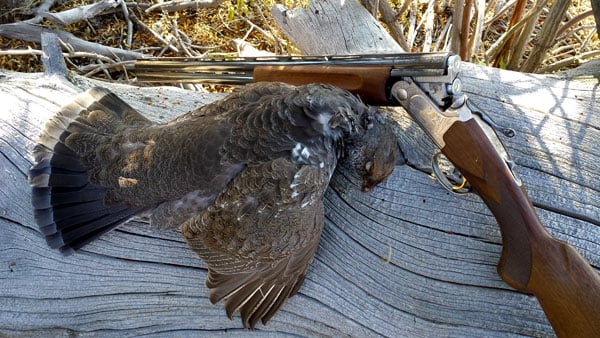
As it turned out, this was the biggest blue grouse of the trip. Ready for roasting, he weighed a shade over 2 3/4 pounds, a gigantic bird. And while he surely would be a trophy on anyone’s wall, this one will be a trophy on my table.
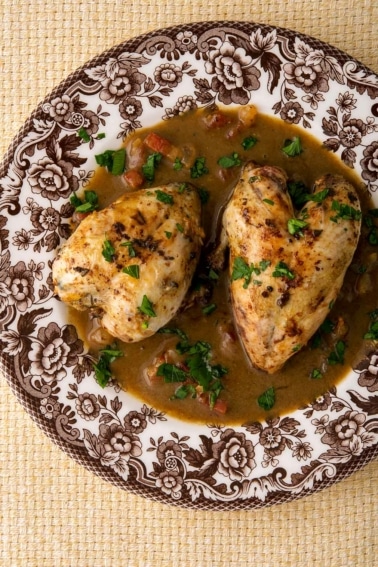
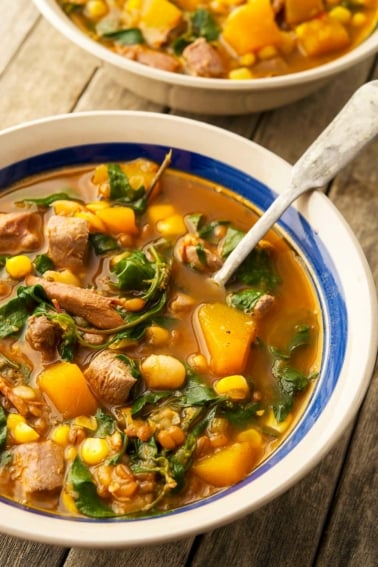
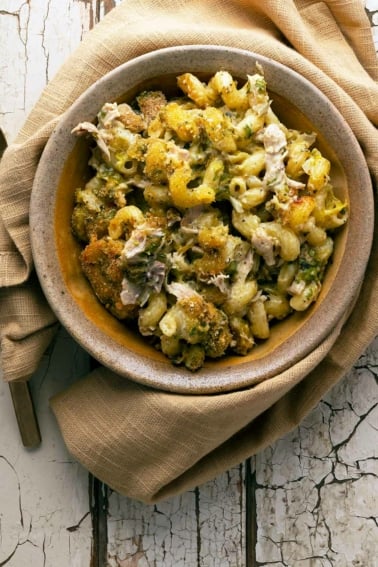

There’s sooty grouse even below 5000 ft in northwest California (coast range and Klamath mountains). Im not going to say exactly where… obviously.
So I got 6 of this babies plucked and gutted in my fridge. I’ve been shooting blue grouse since 1992, but I have never plucked one before. In fact, I hadn’t plucked an upland bird of any kind until Doves a la mancha came calling my name this year. I’ve been perusing your various upland recipes, and have a couple candidates (Perfect Pan Roasted Birds, and Simple Roast Grouse). I am wondering though if the pan roasted technique will cut it on these bigger chickens… What are your thoughts and recommendations? Would you treat them any different than a Ruffy?
Chad: I wouldn’t treat them differently. I’d start with brining and the simple roast recipe, or the pan roasted grouse. Either will work. Pan roasted will taste better, but is a little trickier to cook.
Love the article. I live near the blue mountains here in Oregon and am blessed with great blue grouse hunting. Even though I’m a chukar hunter at heart I love hunting Blue’s. Here I find them 2500 to 4000 feet elevation. I think you have the best wild game recipes I have found . Substituted blue grouse in the general tso and the Kung poa and it was the best. Keep sending the recipes and I’ll keep cooking them. Thank you
Great article Hank. We were chasing Dusky in the Unitas yesterday with the more typical outcome. 🙂 From the picture it looks like you are shooting a Franchi Veloce. Is that correct? It is my favorite upland gun in the safe.
Matt: Indeed it is! The Veloce is the only shotgun I use now, even for waterfowl. I’ve shot swans in Utah with it all the way down to snipe.
Nice Hank. Good to see you’ve been bitten by the “blue bug”. Always hunted, these birds, growing up in B.C. Now that I live in Ontario I drag my poor lab, who grew up at 200 FT., out west, and expect her to chase birds at 6 G. BTW you can find blues at sea level on the coast islands. They seem to take over the habitat of ruffed grouse. In one three day trip, on Texada isle., my friend and I ended up up with 21 (17 of which were head shots with an old .303). We were hunting deer but although we saw tons of does; grouse had to fill the cooler.
Why can’t you have both a trophy and the meat? Yeah, ya don’t get to eat the skin, but you do get the trophy.
nice gun
Here in Idaho I’ve seen Blues and Ruffed as low as 4500′. Training my new pup before the season, I got close enough to a Ruffed that I could have taken it with a broom stick. Needless to say, now that the season has started, I’ve gotten one. Not a bright bird, but they make me look even less intelligent at times.
All said and done though, I’d much rather stroll through forests than bust brush for pheasant!
Hank – the ones I have killed in the Wallowa Mountains were very large, stupid but stealthy and usually hung out at right around 4,000 feet. They were in a very remote area and I’m not so sure that they have ever been hunted before. You could run into one within 20 feet – too close to shoot but they would tend to spook before you could back away.
Mounted in the pot. You just passed the zeneise hunter test-which is a huge compliment. 😀 Congratulations! 🙂
Gorgeous.